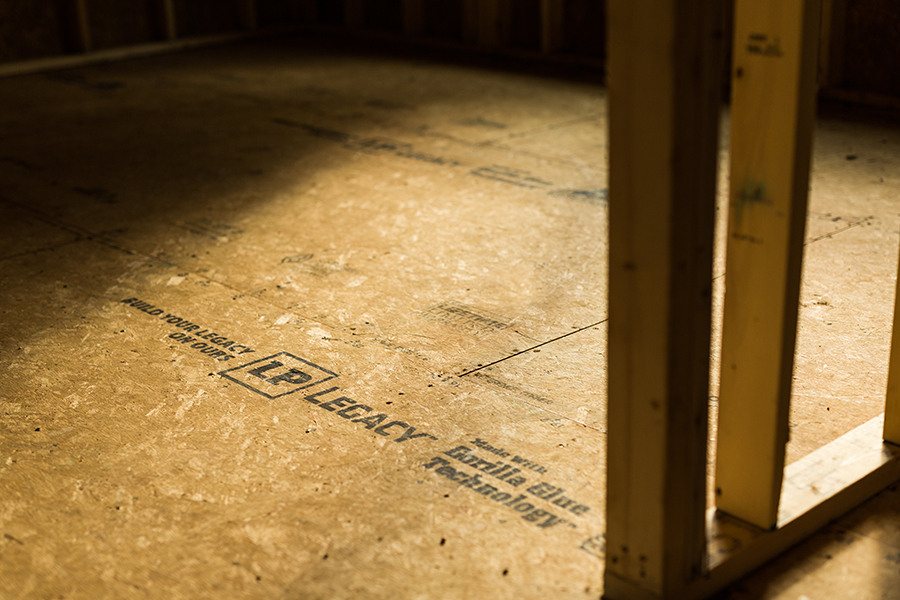Business Advice5 min
How to Repair Water Damaged Sub-Floor
If not discovered quickly enough, a slow leak caused by a faulty dishwasher, ice maker, shower or another appliance will require extensive repairs and possibly the need to replace water-damaged sub-flooring.
As a professional, you know it's a big project to get called to a home to fix sections of water-damaged sub-floor or replace the entire floor due to water damage. Either way, it's disruptive to the family and needs to be addressed as soon as possible.
Here are some questions you may hear from your customers following the discovery of OSB sub-floor water damage and the need for water-damaged sub-floor repairs.
Q. How do I know if my sub-floor is rotten?
A. It's difficult to assess if the sub-floor is rotting until carpets or tile are pulled back and an inspection is conducted. However, if the sub-floor feels spongy and sags when walking across the floor, this is a sign of a rotted sub-floor.
Q. How much does it cost to repair a water-damaged sub-floor?
A. Customers may ask how much it costs to repair a water-damaged sub-floor and, of course, it all depends on a number of factors. Repairing one smaller section versus an entire room or first floor of a single-family home is going to impact the materials and labor costs.
Q: How should you repair water-damaged sub-flooring?
A: After the water is removed and you clean up or remove carpets and hardwood flooring, you have to be concerned with the sub-floors that lay underneath. In some cases, you'll find it's necessary to replace the sub-floor from water damage.
4 Steps to Repair Water-Damaged Sub-floor
If it's determined the partial or full replacement of sub-flooring is needed, here are 4 steps for fixing water-damaged sub-flooring
1. Stop the Water
If water damage was caused by a leaking appliance, the source of the water has to be resolved before taking any steps toward fixing the floor. Whatever the initial cause, make sure the source of the leak has been identified and repaired.
2. Expose the Sub-floor and Examine
Start by removing the baseboards in the room and pull back the carpeting or remove the hardwood floors. If the room or house has another type of floor covering like vinyl, you may be able to cut out sections over the water-damaged sub-floor in some cases.
If the sub-floor has rotted or spongy in any way, it will need to be removed. However, if the sub-flooring appears strong and solid but simply wet, ventilate the area and allow time for the sub-floor to dry. It all depends on the amount of time the water was left to saturate the sub-flooring. If it was a burst pipe and the homeowner quickly shut off the water source and vacuumed up the water, the integrity of the sub-flooring may be okay.
3. Remove Damaged Sub-flooring
If it has been determined that the sub-floor is damaged, it must be cut out and removed Continue cutting away rotted floor until you reach solid structural framing. Floor joists may also be damaged to the point of needing repair. Use a stud finder to locate floor joists; you may need to remove the two joists on either side of the damage.
During the removal process, be certain to get all of the rotted wood out to avoid the spread of mold that may not be visible into the new wood.
Pro Tip: Watch builders Jordan Smith and Kyle Stumpenhorst install LP Legacy® Premium Sub-Flooring.
4. Reinforce Floor Joists and Install New Sub-flooring
Measure and cut the new subflooring. When replacing with LP Legacy Premium Sub-Flooring, use the LP Legacy Premium Sub-Floor Adhesive to help increase the subfloor's stability and strength and to help prevent squeaks.

Leave a 1/8˝ gap between old and new sub-flooring. Use nails to fasten down the new subflooring and drive all perimeter fasteners 3/8˝ back from the panel edges.
LP Legacy Premium Sub-Flooring Limited Warranty
LP Legacy panels are backed by a unique warranty that leads the industry and covers LP Legacy panels during the time it takes to complete your build and long after. With the exception of some marine-type treated products, there aren't any typical subfloor panels on the market that are intended for long-term water resistance. When installing LP Legacy Premium Sub-Flooring, do your best to avoid making mistakes that could void the warranty. For complete LP Legacy limited warranty information, visit https://lpcorp.com/products/panels-sheathing/premium-sub-flooring/warranty.
With the right methods and products, water-damaged sub-flooring can be effectively repaired and replaced. Find out how to best Defend Your Build® against almost anything with LP Structural Solutions products.
Continue Reading
Resiliency Solutions
5 minIntroducing LP® SmartSide® ExpertFinish® Naturals Collection™: Nature-Inspired Beauty Meets Engineered Performance
We're excited to introduce the LP® SmartSide® ExpertFinish® Naturals Collection™, a bold new addition to our trusted line of engineered wood siding and trim that delivers the warmth and beauty of nature with the advanced protection and performance builders and homeowners expect.
Labor Solutions
5 minChoosing the Right LP® Structural Solutions Product for Your Build
When it comes to building strong, reliable, and high-performing structures, the materials you choose matter. At LP Building Solutions, we understand that every project, whether it's a single-family home or a multifamily development, requires structural components that meet your needs for strength, durability, and efficiency.
Sustainability Solutions
5 minBuilding a More Sustainable Future with LP Building Solutions
In today's world, sustainability is no longer just a buzzword, it's a blueprint for responsible living and smarter building. As the construction industry seeks ways to reduce its environmental footprint, LP Building Solutions is focused on providing innovative building materials for eco-conscious builders to help reshape what it means to build sustainably
News & Stories3 min
History of Partnership with Gary Sinise Foundation
The LP Foundation is a proud partner of the Gary Sinise Foundation, which supports wounded veterans in several ways. You can learn more about the LP Foundation here.